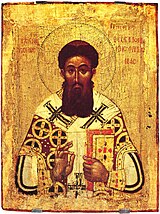
Back غريغوريوس بالاماس Arabic جريجوريوس بالاماس ARZ Грыгорый Палама Byelorussian Рыгор Паляма BE-X-OLD Григорий Палама Bulgarian Gregori Palamàs Catalan Gregorio Palamas CBK-ZAM Gregorios Palamas Czech Gregorios Palamas German Άγιος Γρηγόριος Παλαμάς Greek
Gregory Palamas | |
|---|---|
 Painting of Saint Gregory in Monastery of Vatopaidi, Mount Athos, Greece by Manuel Panselinos. The captions call him, among other titles, Νέος Χρυσόστομος: A New Chrysostom. | |
| Archbishop of Thessalonica | |
| Born | 1296 Constantinople, (modern-day Istanbul, Turkey) |
| Died | 14 November 1357 (aged 60-61) Thessaloniki, Macedonia (modern-day Greece) |
| Venerated in | Eastern Orthodox Church Anglican Communion Eastern Catholic Churches |
| Canonized | 1368, Constantinople by Patriarch Philotheos of Constantinople |
| Major shrine | Thessaloniki Theology career |
| Notable work | Philokalia |
| Theological work | |
| Tradition or movement | Palamism |
| Main interests | Asceticism, mysticism |
| Notable ideas | Essence–energies distinction, theosis, Tabor Light |
| Feast | 14 November, Second Sunday of Great Lent |
| Attributes | Long, tapering dark beard, vestments of a bishop, Gospel Book or scroll, right hand raised in benediction |
| Influenced | Nilus Cabasilas, Gennadius Scholarius, Nicodemus the Hagiorite, Sophrony of Essex, John Meyendorff, Seraphim Rose |
| Part of a series on |
| Palamism |
|---|
 |
|
|
| Part of a series on the |
| Eastern Orthodox Church |
|---|
| Overview |
Gregory Palamas (Greek: Γρηγόριος Παλαμᾶς; c. 1296 – 1359[1]) was a Byzantine Greek theologian and Eastern Orthodox cleric of the late Byzantine period. A monk of Mount Athos (modern Greece) and later archbishop of Thessaloniki, he is famous for his defense of hesychast spirituality, the uncreated character of the light of the Transfiguration, and the distinction between God's essence and energies (i.e., the divine will, divine grace, etc.). His teaching unfolded over the course of three major controversies, (1) with the Italo-Greek Barlaam between 1336 and 1341, (2) with the monk Gregory Akindynos between 1341 and 1347, and (3) with the philosopher Gregoras, from 1348 to 1355. His theological contributions are sometimes referred to as Palamism, and his followers as Palamites.
Gregory has been venerated as a saint in the Eastern Orthodox Church since 1368. Within the Catholic Church, he has also been called a saint; Pope John Paul II repeatedly called Gregory a great theological writer.[2] Since 1971, the Melkite Greek Catholic Church has venerated Gregory as a saint.[3][4] Some of his writings are collected in the Philokalia, and since the Ottoman period, the second Sunday of Great Lent is dedicated to the memory of Gregory Palamas in the Orthodox Church and Ukrainian Greek Catholic Church.[5] The Byzantine Synodikon of Orthodoxy also celebrates his memory and theology while condemning his opponents, including some anti-Palamites who flourished after Gregory's death.
- ^ Rigo, A. (1989), "La vita e le opera di Gregorio Sinaita." Cristianesimo nella storia 10: 579–608.
- ^ Pope John Paul II, Homily at Ephesus, 30 November 1979, General Audience, 14 November 1990, General Audience, 12 November 1997, General Audience, 19 November 1997, Jubilee of Scientists
- ^ "The Search for Sacred Quietude". Newton, MA: Eparchy of Newton. 17 March 2019. Retrieved 12 October 2021.
- ^ "Saint Gregory Palamas". Melkite Greek Catholic Church Information Center. Retrieved 12 October 2021.
- ^ "St. Gregory Palamas". Melbourne: Eparchy of Saints Peter and Paul of Melbourne. 10 February 2010. Retrieved 5 February 2022.
© MMXXIII Rich X Search. We shall prevail. All rights reserved. Rich X Search